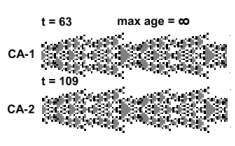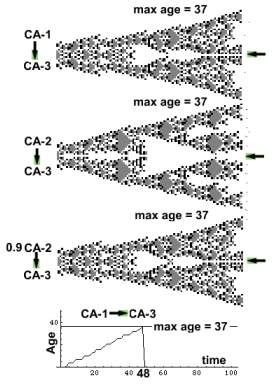 |
Age indicator
 |
Under the control of CA-2, CA3 ages faster. CA-3 mid cell age reaches the max age at t = 2 its age is set to zero (white) and remains so. The entire mid cell line (position = 50) is white. In the last example CA-2 control of CA-3 is slackened. Only 0.8 of the CA-2 age increment is added to the CA-3 mid cell. Now aging proceeds at the same rate as in CA-1. We may thus conclude that CA-2 is about 1.25 (1 / 0.8) times older than CA-1.
 |
zygote -> effect[1, 1000]; go[63] (=CA-1);
zygote -> effect[1, 1000]; go[109] (=CA-2); restoreparams;
age[[3]] +=a[[3]] + toamplify a[[1, 50]] ;age[[3]] +=a[[3]] + toamplify a[[2, 50]]; effect[no, 37]; go[100];
Next page